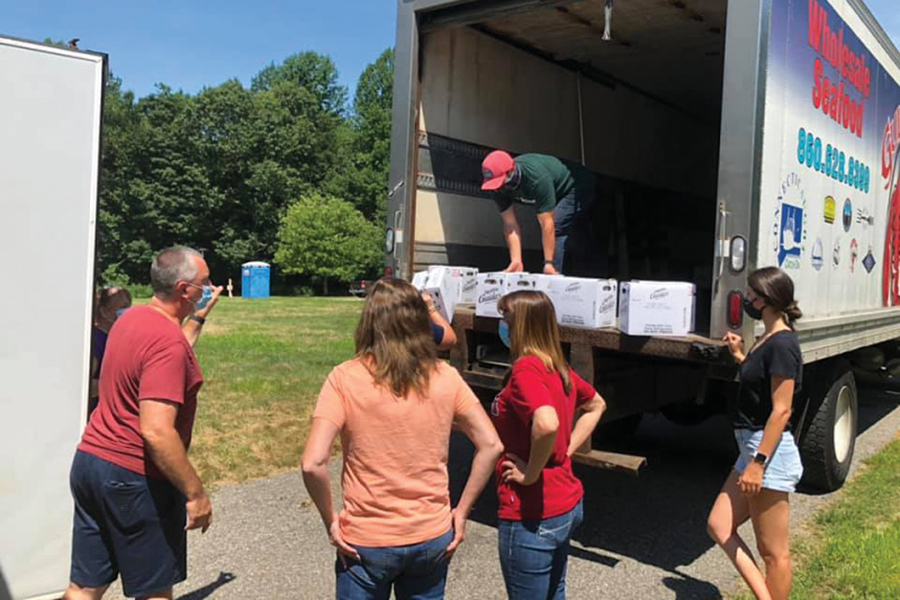Home > Connecticut > Connecticut Organizations Help Farms Pivot During COVID-19
Connecticut Organizations Help Farms Pivot During COVID-19
In partnership with: Connecticut Department of Agriculture

On March 23, Gov. Ned Lamont responded to the coronavirus public health crisis with a directive for Connecticut residents to “Stay Safe, Stay at Home.” Nonessential businesses and shops closed, and many workers switched to telecommuting. But on the state’s 5,500 farms, seedlings continued to grow, livestock still had to be fed and cows kept producing milk – all while quarantined consumers clamored for farm-fresh local products.
Agriculture businesses, listed among the Department of Homeland Security’s 16 critical infrastructure sectors, continued functioning during the shutdown. Rapid, decisive responses from government agencies and industry organizations were vital to helping growers survive the severe disruption of their markets and make sense of a volatile new operational landscape.

Providing Resources
In the early days of the pandemic, farmers urgently needed access to the newest information on government compliance, health protocols, federal aid and more. They also had to quickly devise new strategies for meeting consumer demand, says Connecticut Commissioner of Agriculture Bryan P. Hurlburt.
“Keeping farm stands, farm stores and farmers’ markets open created a window of opportunity for farmers to use their innovative instincts and entrepreneurial spirit to pivot a little bit,” he says.
To aid the industry as it transitioned, the Connecticut Department of Agriculture (DoAg) expanded beyond its normal roles of regulating and promoting. One of its first responses was to create a webpage for COVID-19 resources, including links to more than a dozen guidance documents addressing everything from community gardens to aquaculture operations.
See more: Connecticut’s Farmland Preservation Program Protects the Legacy of the Land
Additionally, Hurlburt’s team produced a social media toolkit and guide to online market platforms to help wholesale growers transition their businesses to direct-to-consumer sales.
DoAg launched a media campaign to keep consumers informed about changes in the market and where to locate locally grown goods. It also partnered with the Northeast Organic Farming Association of Connecticut to expand resources at CTGrownMap.com. “We were looking at how we can make it easy for consumers and farmers to find each other and help manage that interaction,” Hurlburt says.

Staying Connected
Since March of 2020, DoAg has collaborated with state agencies, trade organizations and lawmakers to host a series of virtual town hall meetings to foster communication among the industry’s diverse segments. Among the collaborators on these projects were the Connecticut Farm Bureau Association (CFBA) and University of Connecticut Extension, which have both coordinated their own targeted efforts at buoying the state’s agriculture sector through the crisis.
Don Tuller, president of CFBA and a seventh-generation West Simsbury farmer, says his organization has worked to amplify messaging from DoAg, as well as hosting its own online forums to allow national and state legislators to hear directly from farmers about the impact of the pandemic.
“It was important for them to hear because they were involved in crafting the CARES (Coronavirus Aid, Relief, and Economic Security) Act and other things that determined how aid was delivered within the agricultural community,” Tuller says.
 The UConn Extension put together its own website for COVID-19-related information for both farmers and consumers on production, distribution and processing. This has proved to be a critical resource, according to Indrajeet Chaubey, dean and director of the UConn College of Agriculture, Health and Natural Resources.
The UConn Extension put together its own website for COVID-19-related information for both farmers and consumers on production, distribution and processing. This has proved to be a critical resource, according to Indrajeet Chaubey, dean and director of the UConn College of Agriculture, Health and Natural Resources.
Chaubey also points to a successful Extension initiative that enlisted 4-H members and volunteers to distribute more than 90,000 pounds of surplus milk and other products from Connecticut dairies to 53 food pantries in the state. “Otherwise, the milk producers may have had to dump their milk,” he says. “And those who needed milk for their food and nutrition security would not have otherwise been able to get it and afford it.”
While many of the state’s farms have found success with direct-to-market sales this season, some still face daunting challenges. But Hurlburt has faith in the industry. “Connecticut agriculture has been doing this for hundreds of years,” he says. “We’ll get through this just like every other natural or man-made disaster the state has faced. Tell us what you need, and we’re going to work on it.”
Learn More
To find fresh, local food near you, visit CTGrownMap.com.



